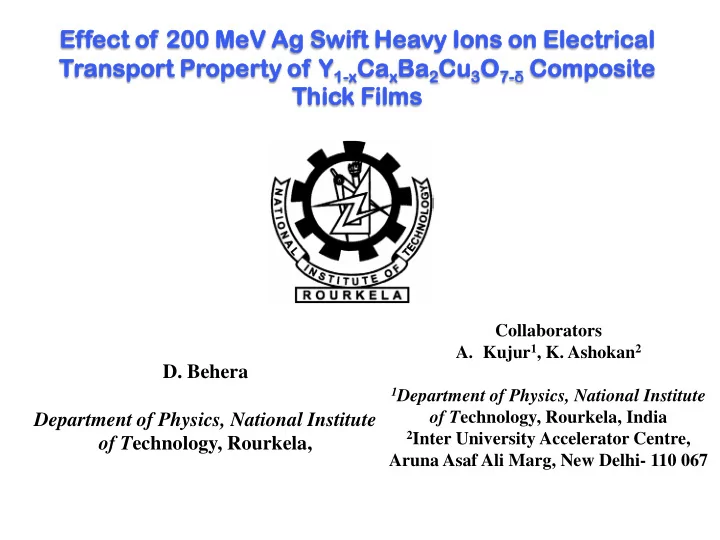

Effect of of 200 200 MeV eV Ag Ag Swift H Hea eavy I Ions ons on on Elec ectrical Trans anspo port P Proper erty ty o of Y 1-x Ca Ca x Ba Ba 2 Cu Cu 3 O 7- δ Compo posite te Thic ick F Film ilms Collaborators A. Kujur 1 , K. Ashokan 2 D. Behera 1 Department of Physics, National Institute of T echnology, Rourkela, India Department of Physics, National Institute 2 Inter University Accelerator Centre, of T echnology, Rourkela, Aruna Asaf Ali Marg, New Delhi- 110 067
Interaction of Projectile with Target Type of Inelastic interaction Elastic interaction interaction Electronic energy loss, Nuclear energy loss Modes of S e = (dE/dx) e S n = (dE/dx) n energy loss Typical Hundreds of MeV A few Kev to MeV Ion energy Low Energy Ions Swift Heavy Ions (SHI)
Electronic Energy Loss (S e ) Projectile ion Nucleus Electron cloud S e = 25.18 KeV nm -1 S th = 20 KeV nm -1 S n = 0.071 KeV nm -1 , which can travel a distance of 12.66 μm in the film. S e is 350 times greater than than S n , hence the material modification is dominated by S e . Implanted Ion Nuclear Energy Loss (S n )
Annealing defects Additional defects Phase change Latent Tracks (S e > S eth ) Electronic energy loss Point defect creation due to secondary electrons
Experimental Sample Preparation Thick film by diffusion reaction technique Substrate Y211+ Ca (green phase) Overlayer Ba 3 Cu 5 O 8 Y211+Ca+Ba 3 Cu 5 O 8 YBCO Y211+Ca+Ba 3 Cu 5 O 8 +Y 2 O 3 YBCO + Y 2 O 3 Irradiation of Thick film by 200 MeV Ag ions of Fluence 5 x 10 11 ions/cm 2 5 x 10 12 ions/cm 2
Structural analysis (XRD) Peaks corresponds to YBCO phase corresponding to space group P mmm orthorhombic. (00 l ) peak intensity falls as a function of ion fluence Decreases the crystalline volume fraction effecting peak intensity to decrease Fall in intensity is due to defect production via secondary electrons creating point defects. Elongation of c axis
Structural analysis (SEM) Densely packed well distributed grains are observed in all the samples
Raman Analysis ~500 cm -1 (stretching of apical oxygen , ~ 440 cm -1 (in phase vibration of O (2) –O (3) oxygen atom in CuO 2 ), ~337 cm -1 (out-of-phase c axis vibration of O (2) –O (3) oxygen atom in CuO 2 plane). The other two Raman active modes are vertical along the c axis given by Ba atoms (~116 cm -1 ) and Cu (2) atoms(~154 cm -l ) 600 cm -1 is associated with defects and oxygen vacancies. oxygen suppression is occurring on the apical site.
Electrical transport property The ratio of ρ 250K / ρ 100K is ~1 indicating that the fall of resistance is decelerated. Increase the residual resistivity ( ρ ο ) . Resistive properties of the samples ρ 250K ρ 100K ρ 0 Samples T cmf T c0 ( mΩcm ) ( mΩcm ) ( mΩcm ) ( K) ( K) YCaBCO/5wt. 83.94 63.37 0.919 0.81 0.792 %Y 2 O 3 Φ = 5x10 11 79.27 54.21 1.807 1.61 1.557 ions/cm 2 Φ = 5x10 12 73.09 51.01 2.451 2.22 2.219 ions/cm 2
Our results → T c decreases Point defects are created by SHI induced secondary electrons around the latent track Point defects Around the Track
A finite tailing is observed in the derivative plot Asymmetry of d ρ /dT peak gives us valuable information about grain boundaries being damaged more than the grain itself T cmf decrease is accounted by vacancy created in CuO chains due to irradiation. The onset of global superconductivity i.e. T c0 drastically reduces.
∆σ = (1/ρ m − 1/ρ n ) = A ε - λ T LD , T SWF changes and 2D regime dominate the flow of activated charge carriers in irradiated samples. ξ (nm) λ SWF λ 2D λ 3D Samples T SWF (K) T LD (K) T* (K) J YCaBCO/5wt. %Y 2 O 3 2.70 .49 1.01 127.45 100.20 173 2.57 0.19 Φ = 5x10 11 ions/cm 2 3.10 .49 1.05 133 105.75 167 3.37 0.33 Φ = 5x10 12 ions/cm 2 2.85 .49 0.88 146 91.52 163 2.93 0.25
Conclusion Increment of residual resistivity Decrement of transition temperature Significant broadening in transition The dominance of 2D regime on irradiation The shifting of the apical oxygen O (4) atom towards the lower frequency side Oxygen loss confirmed by Raman (00l) Peak intensity decreases as a function of fluence
D Behera, NIT Rourkela
Recommend
More recommend